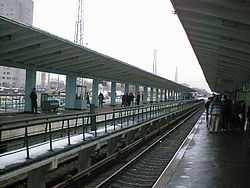Vykhino (Moscow Metro)
| Vykhino | |||||||||||
|---|---|---|---|---|---|---|---|---|---|---|---|
 | |||||||||||
| Station statistics | |||||||||||
| Address |
Vykhino-Zhulebino District South-Eastern Administrative Okrug Moscow Russia | ||||||||||
| Coordinates | 55°42′58″N 37°49′01″E / 55.716°N 37.817°E | ||||||||||
| Line(s) | 7 Tagansko-Krasnopresnenskaya Line | ||||||||||
| Connections |
Bus: 169, 177, 184, 197, 209, 232, 247, 285, 602, 615, 620, 669, 697, 706, 722, 731, 747, 772, 772к, 821, 956 Trolleybus: 30, 64 | ||||||||||
| Levels | 1 | ||||||||||
| Platforms | 2 beach platform | ||||||||||
| Tracks | 2 | ||||||||||
| Parking | No | ||||||||||
| Bicycle facilities | No | ||||||||||
| Baggage check | No | ||||||||||
| Other information | |||||||||||
| Opened | 31 December 1966 | ||||||||||
| Station code | 110 | ||||||||||
| Owned by | Moskovsky Metropoliten | ||||||||||
| Formerly | Zhdanovskaya | ||||||||||
| Services | |||||||||||
| |||||||||||
| Location | |||||||||||
  | |||||||||||
Vykhino (Russian: Выхино) is a station on Moscow Metro's Tagansko-Krasnopresnenskaya Line. Opened on 31 December 1966 as the final part of the Zhdanovskiy Radius, the station has remained the southeastern terminus of the line until 9 November 2013, when the extension to Lermontovsky Prospekt and Zhulebino was opened.[1] The station is unique in many respects. First of all, it was the last station in Moscow (not counting the reconstruction of Vorobyovy Gory in 2002 and the light Metro in 2003) to be built above ground, and the last to have side (as opposed to island) platforms. In fact, the metro station is only part of a combined transfer node, the rest of which consists of the mainline suburban railway (Kazanskoye direction).
Originally designed by A.F. Strelkov and V.F. Cheremin, the whole complex has four platforms, two of which are Island platform. The railway uses four out of the six tracks, whilst the metro uses the other two. It is the only station where is impossible to get from one platform to another without leaving the metro. Two pedestrian subways exist for the transfer between platforms (the transfer complex is above ground level and passengers must ascend to get onto the platforms). Direct railway to metro connections are only possible from Moscow-bound mainline trains onto centre-bound metro trains, where the combined platform is divided lengthwise between the metro and the railway. To transfer in the opposite direction, the subways must be used.
When the transfer complex was built, the long-term passenger load was underestimated. As a result, Vykhino became the busiest and most crowded station of the metro system, due to its position at the edge of Moscow, near many highly populated areas of the hinterland. In addition to the railway traffic, Vykhino also has a large bus station nearby and many passengers from the surrounding Moscow Oblast travel to central Moscow via Vykhino. As a result, the station has some of the largest passenger numbers of the metro network — 176,629 passengers per day at the start of 2009. On the morning rush hour, each third train does not board at this and next - Ryazansky prospekt stations in order to pick up passengers at Kuzminky station with strong bus service.

Initially the railway commuter passenger trains stopped just outside the metro pavilion. However, since the early 1990s they have been making longer journeys well beyond the metro trains' arrival zone and most of the passengers were forced to walk a train length. By the early 2000s it was clear that the transfer point needed a major reconstruction. In 2004 the station was closed to mainline trains (passengers were told to use the Kazansky Rail Terminal instead). During this time the old 1960s concrete hinged roofs on the railway platforms were knocked down. These were replaced with modern light green and white transparent roofs with decorative features. The stairwells from the subways were covered with separate pavilions where turnstiles were inserted, and the concrete floor was repaved with stone. The combined metro and railway platform was re-divided along the width where a pavilion was built. Thus the centre-bound metro platform was nearly trebled in area (accounting for the dismantled ticket offices as well), and safety walls were installed on the railway side. The metro part of the station kept its hinged roofs, but these were completely repainted and the crude lighting elements in the hinges were replaced with never ones. Giving the platform a cleaner look, the subways were also widened and cleaned up with the old tile work replaced by marble. Additional subway was built as well. The complex was re-opened to the public on October 2, 2004.
Behind the station is a surface cross junction used for reversal and the tracks lead on to the Vykhino depot.
Originally the station (as well as the line) was called Zhdanovskaya after Soviet revolutionary and politician Andrey Zhdanov. However in 1988 the station was renamed after name of the district in which it is located.
References
- ↑ "Метро "Жулебино" и "Лермонтовский проспект" открыли для пассажиров". M24.ru (in Russian). November 9, 2013. Retrieved 9 November 2013.
External links
| Wikimedia Commons has media related to Vykhino (Moscow Metro). |
- metro.ru
- mymetro.ru
- KartaMetro.info — Station location and exits on Moscow map (English/Russian)